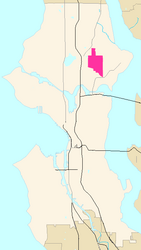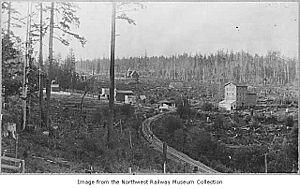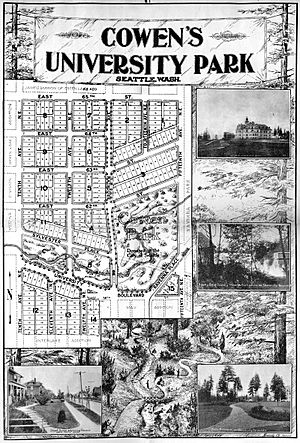Ravenna, Seattle facts for kids
Quick facts for kids
Ravenna
|
|
|---|---|
|
Seattle neighborhood
|
|
|
Cowen Park Bridge
Ravenna-Cowen North Historic District
University Village
|
|

Map of Ravenna's location in Seattle
|
Ravenna is a neighborhood in northeastern Seattle, Washington. It was named after the city of Ravenna, Italy.
Even though Ravenna is mostly a place where people live, it also has many businesses. A big shopping center called University Village is located here.
Ravenna Park is a popular spot in the neighborhood. It's close to University Village. You can also find a walking and biking path nearby. This path connects Green Lake to the Burke–Gilman Trail.
Contents
Discovering Ravenna's History
People have lived in the Ravenna area for a very long time. They have been here since the end of the last Ice Age, about 10,000 years ago. The Duwamish tribe, part of the Coast Salish nations, had a village nearby. This area was like their backyard before settlers from Europe arrived.
Around 1886, the Seattle, Lake Shore and Eastern Railway was built. It followed what is now the Burke-Gilman Trail. In 1890, a man named William Wirt Beck bought a lot of land here. He wanted to create a perfect community. He even built his own home, which is still standing today.
Beck also opened the Seattle Female College in 1890. Classes were held in his home. He planned for churches and other buildings to look like those in Ravenna, Italy. A flour mill was also built in Ravenna in 1890.
Beck saved 70 acres of old-growth trees in a ravine. This area later became Ravenna Park. In 1891, a streetcar line was added. It followed what is now University Way NE.
Ravenna Becomes Part of Seattle
Ravenna became its own town in 1906. But then, Seattle decided to make it part of the city in 1907. This process is called annexation.
The original town of Ravenna had specific borders. These borders stretched from 15th Avenue NE to 20th Avenue NE in some parts. In other areas, they went as far as 30th Avenue NE. The southern border was 55th Street.
Some parts of southern Ravenna were built on land that was filled in. This happened by using dump sites to fill in the drained Union Bay Marsh. University Village, built in 1956, is on some of this reclaimed land.
Where is Ravenna?
Ravenna has clear boundaries with other neighborhoods. To the west, it borders Roosevelt. To the north, you'll find Maple Leaf and Wedgwood. On the east, it's next to View Ridge, Windermere, and Laurelhurst. To the south, it borders the University District. Sometimes, University Village is also considered part of the southern boundary.
The Bryant neighborhood is right next to Ravenna. It's often called Ravenna-Bryant. This area extends east to 45th Avenue NE.
The main road in Ravenna is 25th Avenue NE. Other important roads include 15th and 35th Avenues NE, and NE 65th Street. NE Ravenna Boulevard is a good route for bikes.
One famous street is Candy Cane Lane. Since 1951, people living on Park Road have created amazing Christmas displays. This brings many cars to the boulevard in December! The bridge on 20th Avenue NE was closed to cars in 1975. This made it much safer for bikes and walkers.
Ravenna has some long-standing businesses. An old grocery store has been on the boulevard since the 1920s. Queen Mary is a special place that serves Victorian English Tea. The Duchess Tavern opened in 1934. The only Volvo car dealership in Seattle is also in Ravenna-Bryant.
The old photograph shows the area around the railroad depot in the late 1800s. The Seattle Female College, which opened around 1890, can be seen in the background.
Exploring Ravenna-Cowen Park
The connected Cowen Park and Ravenna Park are at the southwest corner of Ravenna-Bryant. They stretch from where Ravenna Creek starts, under the 15th Avenue bridge, to 25th Avenue NE. These parks are a central part of the neighborhood.
For many years, the park ravine was full of huge, old-growth trees. Some trees were almost 400 feet tall! These trees were even shown at the Alaska–Yukon–Pacific Exposition in 1908. Sadly, these giant trees slowly disappeared by 1926. Today, no trees of that size exist anywhere in the world.
This loss helped people realize the importance of protecting nature. It helped save other parks like Seward and Carkeek. It also encouraged more conservation efforts. Today, a single Sierra Redwood stands near the UW campus. It's about 106 feet tall, which is much smaller than the original trees in Cowen Park-Ravenna Park.
Ravenna Creek's Journey
There have been projects to bring parts of Ravenna Creek back to the surface. This process is called daylighting. One goal is to help native fish return to the creek. These projects also involve building trails and restoring the natural areas along the creek. Sometimes, the University of Washington's environmental science program helps with this work.
Plans to daylight more of the creek have faced challenges. Some property owners, like those at University Village, have disagreed with the projects. Even though new plans would not affect their land, there have been conflicts.






